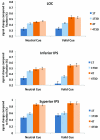Neural representation of targets and distractors during object individuation and identification
- PMID: 23198893
- PMCID: PMC3736830
- DOI: 10.1162/jocn_a_00298
Neural representation of targets and distractors during object individuation and identification
Abstract
In many everyday activities, we need to attend and encode multiple target objects among distractor objects. For example, when driving a car on a busy street, we need to simultaneously attend objects such as traffic signs, pedestrians, and other cars, while ignoring colorful and flashing objects in display windows. To explain how multiple visual objects are selected and encoded in visual STM and in perception in general, the neural object file theory argues that, whereas object selection and individuation is supported by inferior intraparietal sulcus (IPS), the encoding of detailed object features that enables object identification is mediated by superior IPS and higher visual areas such as the lateral occipital complex (LOC). Nevertheless, because task-irrelevant distractor objects were never present in previous studies, it is unclear how distractor objects would impact neural responses related to target object individuation and identification. To address this question, in two fMRI experiments, we asked participants to encode target object shapes among distractor object shapes, with targets and distractors shown in different spatial locations and in different colors. We found that distractor-related neural processing only occurred at low, but not at high, target encoding load and impacted both target individuation in inferior IPS and target identification in superior IPS and LOC. However, such distractor-related neural processing was short-lived, as it was only present during the visual STM encoding but not the delay period. Moreover, with spatial cuing of target locations in advance, distractor processing was attenuated during target encoding in superior IPS. These results are consistent with the load theory of visual information processing. They also show that, whereas inferior IPS and LOC were automatically engaged in distractor processing under low task load, with the help of precuing, superior IPS was able to only encode the task-relevant visual information.
References
-
- Brainard DH. The Psychophysics Toolbox. Spatial Vision. 1997;10(4):433–436. - PubMed
-
- Broadbent DE. Perception and communication. Pergamon Press; New York: 1958.
-
- Corkin S. Acquisition of motor skill after bilateral medial temporal-lobe excision. Neuropsychologia. 1968;6(3):255–265.
-
- Corkin S. What’s new with the amnesic patient H.M.? Nature reviews Neuroscience. 2002;3(2):153–160. - PubMed
Publication types
MeSH terms
Grants and funding
LinkOut - more resources
Full Text Sources
Other Literature Sources
Medical





